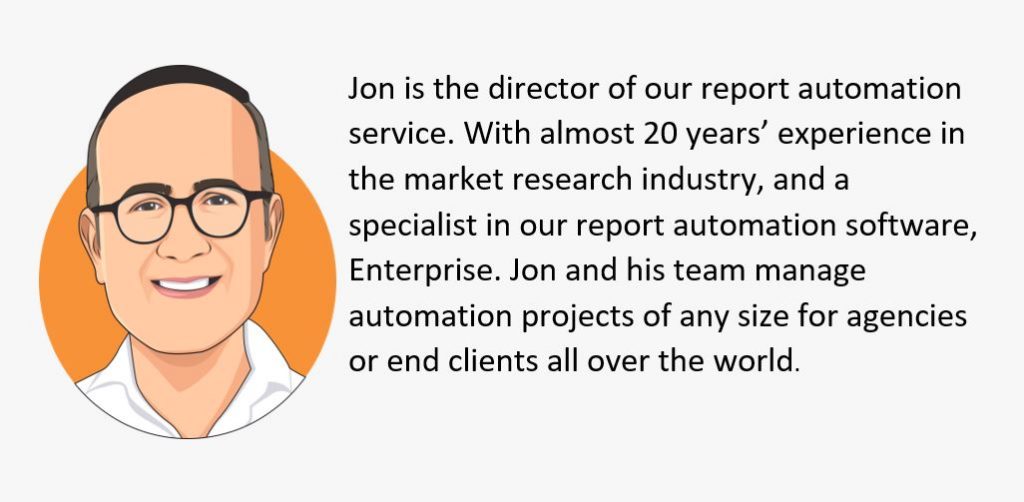Automate Your Reports, by Jon Hackenbroch
When thinking about automating projects the first reaction is often to think of the hardest, most time-consuming project. While this can obviously have the greatest return on the investment, we shouldn’t forget the simpler quicker win projects, as automation of these can also offer great benefits. I always recommend to consider all projects for automation. To demonstrate this, I will review a number of project types that in our experience are clear winners for automation.
Multiple Outputs or Sections
Any template that contains repetition is a good candidate for automation, this could be repeating segments or different markets, as well as multiple brands or statements.
In this case we will setup the automation for the core requirements and just repeat it for all the subsequent versions. The reporting requirements don’t need to be 100% the same in each report. E-Tabs’ automation (www.e-tabs.com) allows us to handle variations in the template, whether this is different brands or even the colours and logos used on the slides, and it can also automatically remove charts or slides that aren’t needed in some of the reports.
A good example of this would be a brand awareness report across different countries, each country could have different local brands used in the comparisons. We would setup the automation to work with the different reporting requirements. Another example could be a segmentation study where the same set of slides need to be repeated for different segments of the data.
Trackers / Multi Wave
When I started in automation almost 15 years ago, tracker projects were always the first to be considered for automation. While these templates have changed a lot over the years – I don’t see static line charts so much anymore – there is still a good consistency between runs. These reports will tend to run frequently with a short turn-around time. Trackers once automated, will often have a long run life so the return on the investment lasts for a long time. The extra time saved by automation can either be used for further analysis of the data, or running additional slides or segments. Finding ways to add value to your projects, will separate you from the competition.
Concepts Test
Any project where you have a core questionnaire and template that is reused for future runs of the same survey – whether this is for changing brands or categories.
In these cases, the core slides remain very similar to previous runs. The changing of brands, logos and colouring makes the report unique, but the underlying design and content is consistent. When we automate these, we create a “blank canvas” that can be filled with varying content depending on the category or brand reported.
High Volume, Peer Comparison or Multi Levels
Reports where you have a high number of outputs, these can be short templates but running for numerous cuts of the data. These cuts could have different comparisons or benchmark requirements. Perhaps comparing to specific peer groups or to others in the same region or industry.
I have seen great use of this report type in business consulting projects, comparing their clients to peers or industry numbers. Employee satisfaction projects are also a good example, as these will often have different locations, departments, teams etc. We can automate the different levels of the reporting hierarchy, taking into consideration any comparison rules.
Key Questions
When reviewing projects for automation I work through a number of questions to be sure I understand the project requirements and scope. As with all projects, there will inevitably be surprises and scope-creep, but these core questions will help you identify the important factors from the start.
- Template format and size?
- Is the template signed off? Working on a changing template can be a bad idea, unless you know some elements are fixed and won’t change.
- Complexity of the slides, which types of charts or tables are included?
- What is the data format and do you have historical data if needed?
- Number of reports required and how frequently?
- Variation between reports, can we use a single template for all reports? Any changing brands?
- Is there significance testing needed in the report, will this be in the tables?
- What is the project timeline?
- Can we use interim, dummy or previous wave data to build the automation?
- Any complex reporting requirements or conditions? Formatting, low base rules etc.
If you have any questions, tips or would like to discuss your next project for automation with Jon Hackenbroch, please fill in the form below and he will be in touch!



